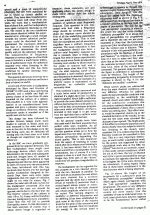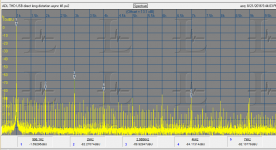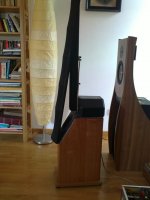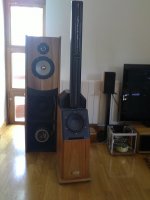I personally have never understood the whole BC1 tweeter concept and can see why that would give horrid off axis issues. But the spendor/Harbeth approach has never really appealed to me. Now I have only owned American speakers since 1990 but if I had money and were buying from the heart in a totally irrational way it would be ATC 3-ways. Those to me are classic british monitors.
Good DACs are cheap too. But when DSP, DAC and monster amp are in in one box you can charge a premium. esp with the proprietary software.
Looking online looks like the amp combos are around 7k of the 20k price, so nice little extra. And 7k for 4x2.5kw... That can't sound good that cheap 😛
EDIT: looking at UK prices, a pair of speakers is £8840 and the amps £7600. Of course not clear if they will sell you just the speakers, but £15k, whilst a lot is low for the a big active system.
You can buy the speakers on their own, and I did. The DSP is handled by 2 miniDSP units and the FIR taps have been made available on the Lansing Heritage forum. I'm using a Crown K2 (that cost me £250 used) on the woofers and Ncore 400s on the CDs.
These speakers are jaw droppingly good.
If I read you right what you are saying is that the M2/econowave/Gedlee approaches match your approach with the usual differences of opinion (JBL like 120degree horns, Earl likes 90 with a 22.5 toe in to cross ahead of listener and will trade a dip in on axis for low HOMs)?
Certainly those of us who grew up on minimonitors have had a challenge to get our heads around using a 15" up to 1Khz, but it certainly appears to work.
Bill,
I personally designed for a 90 degree inclusive angle in my horn designs as Earl did as that seemed to be a very good compromise and was a good match for the driver below it at crossover. Earl and I seem to agree on many points about horns though I am not a big fan of round mouth shapes due to size constraints. On the matter of going from a 15" to a horn I have done that in the long lost past but never went as high as 1khz for crossover, I just felt the 15 had to many modes that high and was to directional by that frequency, I tried to cut by 600hz myself. What I did later was go three way with a mid cone driven horn and then a 1" compression driver on a short fast flare covering the upper range.
For a small two way monitor I went in the direction of a smaller 6-8" driver to match a dome tweeter. I never used a 10" or greater to match up to a 1" dome, that just leaves so many problems of integration, at least with no possibility of dsp then or any passive correction that worked or will ever really work to cover the problems.
I love the idea of dsp now and getting away from complex passive networks and all those expensive matched polypro caps and expensive air core inductors and of course wirewound resistors and still the real impossibilities of any real time coherency at the crossover point. I have boxes of Erse air core inductors that I don't know if they are worth more as inductors or just copper cost!
Someone made the comment about the problems with the cone breakup with the polypropylene cones and I must add the bextrene cones to that family that lead me to develop the cone material that I've developed and will be used in my small monitor speaker. Trying to control the cone breakup while also having a fairly fast decay rate which I must say the polypro doesn't do well was a big motivation in this quest, plus it was a challenge from my friend who was my mentor at the time in speaker design. I also had some serious problems with the direction that other composite cone developers have taken, trying to create the mythical infinitely rigid cone, not a good idea in my eyes. I'd rather use paper than most composite cone materials out there today.
My own development models used a 6 1/2" cone driver with a 1" dome tweeter, the tweeter was not mine at the time but was a really well behaved Audax dome tweeter that measures beyond what you'd expect from an inexpensive dome. I will be building up my latest 1" dome Be driver with all the features I plan on using in my monitor. I have some raw 1010 steel, try getting that in the USA in bar form, to go on my lathe and the Be domes and need a few other components to put it all together. It is much harder to find the soft parts for dome tweeters than it is for cone drivers so that is going to be a challenge on the surround, but I think I can make a simple vacuum form tool and make what I need. Getting the correct extruded thermoplastic PU elastomer is going to be a neat trick though without having to have someone extrude it for me special. I'm thinking injection molding the final surround for consistency and cost.
Anyway this isn't a thread about my development so I'll stop here. Needless to say I am working with a couple of people from this forum on the electronics side of this speaker and I hope to finally put this design to bed, the electronics have held it up for far to long. Opinions on what people would really want in a wireless speaker are appreciated though. I'm still not sure I want to go completely wireless without the possibility of at least a simple rca input for those with existing electronics, that is something I have been seriously thinking about.
Let me reduce some of the perception issues-
1) Flat response and the microphone and speaker do not guaranty good sound. In fact it seems people usually find it unsatisfactory
2) in the original recording the engineer/producer has various tools to improve the sound, microphone positioning, microphone selection, mixing extra microphones eq etc.
3) at the mixing/mastering stage: more eq/effects and the ability to adjust the balance of multiple microphones.
4) At playback selection of electronics with their interaction and particular character if any. EQ from bass and treble controls to full DSP adjustments.
5) Speakers in response on axis, off axis speakar balance controls etc.
The underlying problem is that at each stage efforts can be made to "improve" the perceived sound. They are all independent and still interactive. if at recording the speakers and their installation was selected to sound "right" for certain recordings and then other recordings were adjusted and improved for that situation you still are not returning to a "pure" sound. Its the collection of the subjective judgements of all the players in the chain, most not having any interaction with each other and all starting from a departure from "pure". And the departure from "pure" is quite valid, but what is needed is different for pretty much every listener.
You can argue back and forth about a BBC dip, but if the speaker has it and a recording engineer also implemented it for various reasons (like speakers that are flat) then it may be too much for some population of listeners. Ultimately this gets to be a very quicksand like foundation for judgements.
At the headphone conference in Denmark right now Sean Olive presented a paper on preferred balance of bass in headphones. The results are interesting and underscore the lack of an absolute answer of "correct" response.
1) Flat response and the microphone and speaker do not guaranty good sound. In fact it seems people usually find it unsatisfactory
2) in the original recording the engineer/producer has various tools to improve the sound, microphone positioning, microphone selection, mixing extra microphones eq etc.
3) at the mixing/mastering stage: more eq/effects and the ability to adjust the balance of multiple microphones.
4) At playback selection of electronics with their interaction and particular character if any. EQ from bass and treble controls to full DSP adjustments.
5) Speakers in response on axis, off axis speakar balance controls etc.
The underlying problem is that at each stage efforts can be made to "improve" the perceived sound. They are all independent and still interactive. if at recording the speakers and their installation was selected to sound "right" for certain recordings and then other recordings were adjusted and improved for that situation you still are not returning to a "pure" sound. Its the collection of the subjective judgements of all the players in the chain, most not having any interaction with each other and all starting from a departure from "pure". And the departure from "pure" is quite valid, but what is needed is different for pretty much every listener.
You can argue back and forth about a BBC dip, but if the speaker has it and a recording engineer also implemented it for various reasons (like speakers that are flat) then it may be too much for some population of listeners. Ultimately this gets to be a very quicksand like foundation for judgements.
At the headphone conference in Denmark right now Sean Olive presented a paper on preferred balance of bass in headphones. The results are interesting and underscore the lack of an absolute answer of "correct" response.
In the Bowles test, the LF signal forces shifts in the devices parameters that can provide insights into amplifier stability.
For example, the 7th harmonic of 100 Hz is 12.8 kHz.
No Sir the 7th harmonic of 100Hz is 700Hz 🙄
As Demian just mentioned there are modifications made to the equalization all through out the recording process that discount any tuning done by individual musician for a particular sound. I would profit to say even in an orchestra that there is more tuning going on than many would like to admit.
Now when it comes to playback there are no real exacting standards and more than likely there never will be. I personally have a preference for a bit of extra bass impact especially at lower listening levels, you could say that is because of Fletcher Munson types of hearing curves but I think it goes beyond that to sound preferences. It is one reason why I have never understood why audiophiles insist on no tone control circuits, as if there is one exact way that playback should be and the end user should have no input as to what that sound should be. Since there are no real standards and perfectly flat FR doesn't always sound best and often isn't even correct I don't know why I don't see more conversations on how to implement quality tone control circuits? Something that doesn't screw up the phase response and add other colorations besides just bending the FR. I don't know that I have ever seen Parametric tone controls on a consumer product, third octave yes, but those are usually horrid in end results with phase shifts at each 1/3 octave control. I would look seriously at a JC Parasound tone control unit if it was available. I had parametric tone controls on my Monolithic company sound system in my car and would love to have something similar for in home use. Yes I could just get a Pro-Audio unit but that isn't what most consumers would ever do or know of.
Now when it comes to playback there are no real exacting standards and more than likely there never will be. I personally have a preference for a bit of extra bass impact especially at lower listening levels, you could say that is because of Fletcher Munson types of hearing curves but I think it goes beyond that to sound preferences. It is one reason why I have never understood why audiophiles insist on no tone control circuits, as if there is one exact way that playback should be and the end user should have no input as to what that sound should be. Since there are no real standards and perfectly flat FR doesn't always sound best and often isn't even correct I don't know why I don't see more conversations on how to implement quality tone control circuits? Something that doesn't screw up the phase response and add other colorations besides just bending the FR. I don't know that I have ever seen Parametric tone controls on a consumer product, third octave yes, but those are usually horrid in end results with phase shifts at each 1/3 octave control. I would look seriously at a JC Parasound tone control unit if it was available. I had parametric tone controls on my Monolithic company sound system in my car and would love to have something similar for in home use. Yes I could just get a Pro-Audio unit but that isn't what most consumers would ever do or know of.
Voltwide I think Bonsai is correct on his 7th harmonic value of 100hz.
100, 200, 400, 800, 1600, 3200, 6400, 12800
Now I see the googly eyes!
100, 200, 400, 800, 1600, 3200, 6400, 12800
Now I see the googly eyes!
Last edited:
Harmonics are 2X, 3X, 4X etc.of the fundamental as in the attached illustration. Its also confusing that the 2nd harmonic as we call it is the first harmonic in the sequence.
The plot is a particularly poor USB headphone amp that probably has a cult following.
The plot is a particularly poor USB headphone amp that probably has a cult following.
Attachments
EQ without phase shift is essentially impossible although you can add phase equalizers to attempt to remove the effects of the frequency changes. Actually you want those phase eq's as well to correct for the phase errors that accompany the frequency errors you are correcting.
traditionally eq was shunned because it never sounded good and got a real bad rap. It still offends most audiophiles who don't really know what it is. Using it well requires learning, care and skill or a simple desire to make a boom box.
traditionally eq was shunned because it never sounded good and got a real bad rap. It still offends most audiophiles who don't really know what it is. Using it well requires learning, care and skill or a simple desire to make a boom box.
No Sir the 7th harmonic of 100Hz is 700Hz 🙄
Sorry - you are correct!
I was thinking octaves.
Too much ******* port.
Thanks for pointing this out.
🙂
Demian is it still not possible to correct FR in the digital domain without the phase shift or does it also appear when manipulating in the digital domain? I understand there are no analog eq's without phase shifting around the center frequencies but wasn't the use of the parametric eq much less phassy than the old 1/3 octave eq units.
Octave, harmonics, oh my, and I wasn't even drinking unlike Bonsai.
And hay what's wrong with a smiley face eq curve!
Octave, harmonics, oh my, and I wasn't even drinking unlike Bonsai.
And hay what's wrong with a smiley face eq curve!
Last edited:
In my time I've designed some loudspeakers. I was reading a lot about Linkwitz loudspeaker design. What I have found that its quite important to have similar horizontal (actually toward a listener) dispersion around crossover frequency.
In one of my design I used Scan Speak 18W-8545k0 midwoofer and Newform Research R30 ribbon twitter. The crossover frequency was 1 kHz. To get similar sound dispersion around the crossover point I angled the woofer by about 30 degree, look the photo, I like that loudspeaker alot(behind is Orion from Linkwitz)
By the way what do you think about open baffle concept prefered by Linkwitz?
Damir
In one of my design I used Scan Speak 18W-8545k0 midwoofer and Newform Research R30 ribbon twitter. The crossover frequency was 1 kHz. To get similar sound dispersion around the crossover point I angled the woofer by about 30 degree, look the photo, I like that loudspeaker alot(behind is Orion from Linkwitz)
By the way what do you think about open baffle concept prefered by Linkwitz?
Damir
Attachments
Last edited:
That was my experience in the Audiophile wars. Tone controls were dropped because they were often not very well thought out - and didn't help more than they hurt. Dropping the tone control was part of the quest for a pure, simple signal path. Did it originate with Japanese audiophiles?traditionally eq was shunned because it never sounded good and got a real bad rap.
Some of the old fellows here might remember is differently.
Demian is it still not possible to correct FR in the digital domain without the phase shift or does it also appear when manipulating in the digital domain? I understand there are no analog eq's without phase shifting around the center frequencies but wasn't the use of the parametric eq much less phassy than the old 1/3 octave eq units.
Octave, harmonics, oh my, and I wasn't even drinking unlike Bonsai.
And hay what's wrong with a smiley face eq curve!
The phase shift comes from the math. One change necessitates the other. Good DSP UI will show both. However I doubt you could hear the phase effects unless the frequency effects are huge.
Voltwide I think Bonsai is correct on his 7th harmonic value of 100hz.
100, 200, 400, 800, 1600, 3200, 6400, 12800
Now I see the googly eyes!
certainly not!
There is such an elegance and beauty in this
https://upload.wikimedia.org/wikipedia/commons/2/2f/Moodswingerscale.svg
As easy as counting 1,2,3...
All in a piece of vibrating string and everything else which has to do with those.
https://upload.wikimedia.org/wikipedia/commons/2/2f/Moodswingerscale.svg
As easy as counting 1,2,3...
All in a piece of vibrating string and everything else which has to do with those.
Last edited:
The phase shift comes from the math. One change necessitates the other. Good DSP UI will show both. However I doubt you could hear the phase effects unless the frequency effects are huge.
There are ways to cancel the phase shift, but it doesn't come free. FIR filters can do it in the digital domain. VST EQ plugins that do that are usually referred to as linear phase. An old analog trick for doing it is to apply half the EQ and record to tape. Turn the tape over so it it traveling backwards over the recording heads and add the other half of the EQ. Either way, you end up with "pre-ringing" type effects since you are applying some of the EQ backwards in time.
- Status
- Not open for further replies.
- Home
- Member Areas
- The Lounge
- John Curl's Blowtorch preamplifier part II




